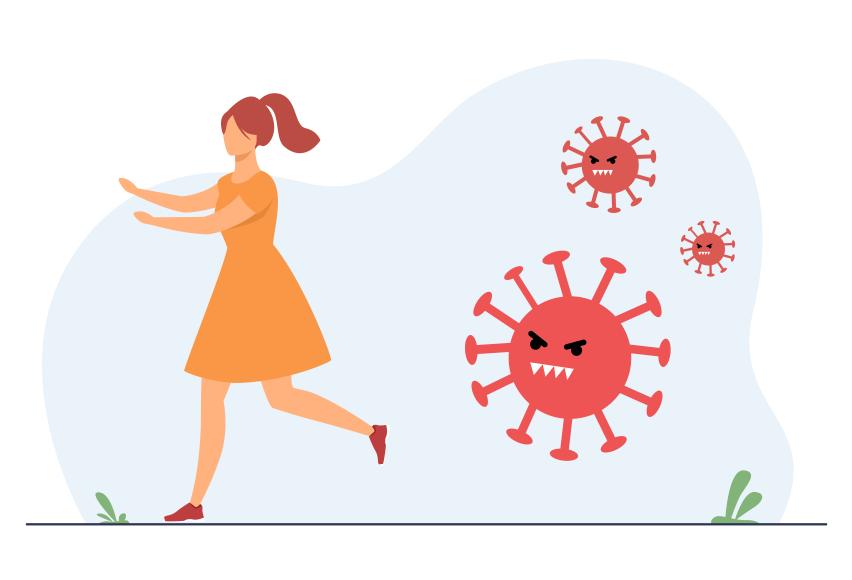HRT and the Reduction of Risky Behaviors

Online test
Find out the severity of your symptoms with this free online test
The Covid pandemic, coming up on year three, caught the world off guard. Seemingly overnight, we changed everything from how we worked, how we played, and even how we cared for ourselves. We learned more about infection control and hygiene, handwashing, and avoiding hand-head contact than we ever thought we would need to. Masks and hand sanitizer became our new best friends, and the new hygiene mantra was handwashing, social distancing, and don’t touch your face!
What we also learned was just how hard it is to not touch your face, eyes, or mouth and just how often we do so without even thinking. Research prior to the Covid-19 pandemic found that we touch our faces on average of 17.8 times an hour. Even when people know the risk of infection, such as those in the medical profession, they continue to repeatedly touch their faces.
Hand-to-head touching seems to be a largely unconscious behavior and not unlike the behavior seen with body-focused repetitive disorders (BFRBs) like skin picking. While the two circumstances cannot be compared, the similarities of the action have not gone unnoticed by researchers and those who treat BFRBs using strategies such as Habit Reversal Training (HRT). In fact, it has been suggested that using strategies like HRT might be beneficial in reducing hand-head touching behaviors in the general population as a way to help reduce the spread of viral infections like the flu and Covid-19.
With that in mind, a recent study sought to explore the possibility of using an HRT-based approach to reducing hand-to-head contact. Could such an approach work for such a widespread and ingrained behavior? If so, how might that intervention look?
Habits and HRT
Habits are repetitive behaviors that largely occur out of one’s awareness and are automatically reinforced. HRT was originally developed to treat repetitive behaviors such as tics, nail biting, skin picking, and hair pulling. It has shown to be very effective in reducing a wide range of habitual or repetitive behaviors and is in fact, considered the “gold standard” for treating BFRBs like skin picking. Because of its efficacy in managing other hand-to-head behaviors like skin picking and hair pulling, it seems to be a potentially helpful intervention for reducing face touching.
Two of the core elements, awareness training and competing response training, seem to be particularly effective for habit reduction.
Awareness training involves bringing awareness to the behavior by observing thoughts, feelings, and behavior, when it happens, where it happens, how it happens, and what triggers it. As awareness improves, you can begin to use strategies to discourage the behavior.
Competing responses interfere with or disrupt the target behavior, in the case of the study’s focus, face touching. In this phase of HRT, the person learns strategies to disrupt or avoid the behavior until the urge passes. For example, they might wear gloves or make a fist or use a fidget or fiddle object until the urge passes.
To determine the potential efficacy of using HRT for the reduction of hand-to-face or hand-to head behaviors, the researchers reviewed a total of 39 studies that used HRT for treating various hand-to-head behaviors. Thirty-five of the 39 studies reported robust reductions in behavior. Treatment gains were also maintained over time. When relapses did occur, “booster sessions” were often successful in re-establishing the treatment effects. While HRT has not been well-studied with benign face-touching behaviors, these review findings led the researchers to suggest that HRT could be a viable intervention for reducing hand-to-face touching associated with viral infection.
Practical Ways to Use HRT with Face-Touching
Based on their literature review, the researchers offer a number of suggestions for the use of a self-directed HRT for reducing a habit like face-touching.
Practice Awareness Training
- Identify how you touch your face. What is the behavior you use? For example, do you touch your eyes or your mouth? Do you rub your eyes or scratch your nose? Note where you are and what you’re doing when it happens.
- Notice when you’re doing it. Practice stopping just short of actually touching your face. Pay attention to the motion and sensations. As you gain awareness, you will be more likely to notice when you’re about to touch your face.
- Try other strategies too. If you find you’re still habitually touching, try making a video to see if you can identify patterns. Enlist the help of a trusted friend or family member who can point out when you’re touching your face. Wear something that will alert you to the movement like a bracelet that jingles or tape on your fingers.
Learn Competing Responses
Competing responses compete with, disrupt or replace the behavior you want to change. Using a competing response has three steps:
- Choose a simple action that would make face-touching impossible. Maybe you wear gloves or hold a fidget.
- Practice using the competing response you chose. You can use the same exercise you used while learning awareness. Simulate the touching behavior stopping just short of actually touching your face. At that point, use your competing response.
- Use your competing response. Use it whenever you find yourself about to touch. Remember, it takes time to break a habit and replace it with a new behavior, so you want to use your competing response often.
- You can also continue to use your support person or reminders if you need to.
When it comes to breaking habits and changing behaviors, it’s important to remember that the habit, especially a deeply ingrained one, was not formed in a day and will not be eliminated overnight. It takes time and attention, but it is doable. HRT has a long and successful track record of reducing unwanted repetitive behaviors. Can it help reduce the face-touching associated with the spread of infections like Covid-19? Possibly. More research is needed but the first step is for someone to ask the question.
References
1. Morita, K., Hashimoto, K., Ogata, M., Tsutsumi, H., Tanabe, S., & Hori, S. (2019). Measurement of face-touching frequency in a simulated train. E3S Web of Conferences, 111, 02027. https://www.researchgate.net/publication/335139603_Measurement_of_Face-touching_Frequency_in_a_Simulated_Train
2. Elder, N. C., Sawyer, W., Pallerla, H., Khaja, S., & Blacker, M. (2014). Hand hygiene and face touching
in family medicine offices: A Cincinnati Area Research and Improvement Group (CARInG) net-
work study. Journal of the American Board of Family Medicine, 27(3), 339–346. https://www.jabfm.org/content/27/3/339
3. Heinicke, M. R., Stiede, J. T., Miltenberger, R. G., & Woods, D. W. (2020). Reducing risky behavior with habit reversal: A review of behavioral strategies to reduce habitual hand‐to‐head behavior. Journal of Applied Behavior Analysis, 53(3), 1225-1236. https://doi.org/10.1002/jaba.745
Online test
Find out the severity of your symptoms with this free online test
Start your journey with SkinPick
Take control of your life and find freedom from skin picking through professional therapy and evidence-based behavioral techniques.
Start Now



